Contents
- GST mop-up hit by Covid
- India to deploy naval liaisons at Madagascar, Abu Dhabi
- Earthquake of 5.3 magnitude jolts parts of Gujarat
- Persistent global transmission of chikungunya from India
- NBWL calls for study on impact of sand mining in U’khand
- Malabar gliding frog spotted at Pullad
GST MOP-UP HIT BY COVID
Focus: GS-III Indian Economy
Why in news?
Amid the chorus for GST compensation from states, the Centre has conveyed that there is a need to factor in the “abnormal situation” due to the coronavirus pandemic indicating that there was no insurance for 14% growth in GST collections during these times.
While introducing GST, the Centre had promised to compensate states for “revenue loss”, if collection growth was under 14% in a year. Compensation is a larger issue.
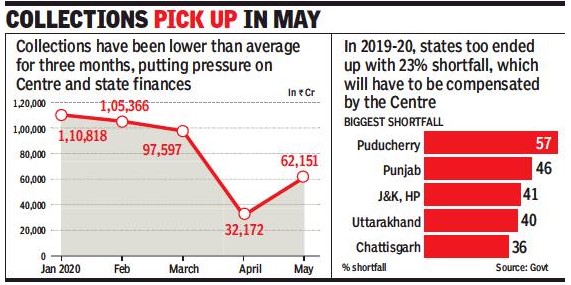
Details
- Data presented at the GST Council meeting showed that GST Collections in May 2020 were 38% lower than in May 2019.
- The Centre has agreed to look into the issue of compensating states, as it was suggested that the Council could look at the option of market borrowings.
- However, it may not be possible for the Centre to compensate if a state fails to achieve 14% annual growth in GST collections.
What is Goods & Services Tax (GST) in India?
- In simple words, Goods and Service Tax (GST) is an indirect tax levied on the supply of goods and services.
- GST is one indirect tax for the entire country.
- The GST became applicable from 1st July 2017 after the enactment of the 101st Constitution Amendment Act, 2016.
- The Goods & Services Tax Act came into effect in 2017, which is a for GST – a comprehensive, multi-stage, destination-based tax that is levied on every value addition.
- GST has replaced many Indirect Taxes in India, and Goods and Service Tax Law has replaced many indirect tax laws that previously existed in India.
What are the components of GST?
- There are 3 taxes applicable under this system: CGST, SGST & IGST.
- Central Goods and Service Tax CGST: Collected by the Central Government on an intra-state sale (Eg: transaction happening within Maharashtra)
- State Goods and Service Tax SGST: Collected by the State Government on an intra-state sale (Eg: transaction happening within Maharashtra)
- Integrated Goods and Services Tax IGST: Collected by the Central Government for inter-state sale (Eg: Maharashtra to Tamil Nadu)
CGST
Revenue under CGST is collected by the Central Government.
CGST subsumes the below given central taxations and levies:
- Central Excise Duty
- Services Tax
- Central Sales Tax
- Excise Duty
- Additional Excise Duties Countervailing Duty (CVD)
SGST
Revenue under SGST is collected by the State Government.
SGST subsumed the following state taxations:
- Luxury Tax
- State Sales Tax
- Entry tax
- Entertainment Tax
- Levies on Lottery
IGST
- IGST is charged when there is movement of goods from one state to another state.
- The revenue will be collected by the central government and accordingly will be shared between the Union and states in the manner prescribed by Parliament or GST Council.
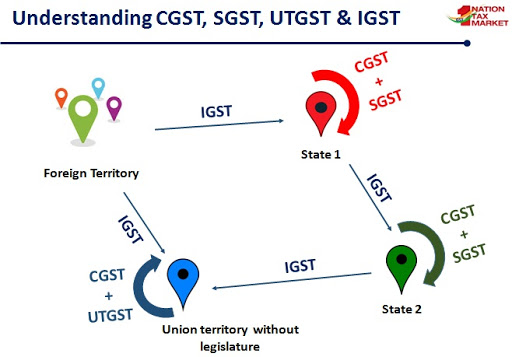
What is GST Compensation?
- The Centre promised compensation to the States for any shortfall in tax revenue due to GST implementation for a period of five years. This promise convinced a large number of reluctant States to sign on to the new indirect tax regime.
- As per the GST Act, states are guaranteed compensation for any revenue shortfall below 14% growth (base year 2015-16) for the first five years ending 2022. GST compensation is paid out of Compensation Cess every two months by the Centre to states.
GST Council
- Goods & Services Tax Council is a constitutional body for making recommendations to the Union and State Government on issues related to Goods and Service Tax.
- GST Council is an apex member committee to modify, reconcile or to procure any law or regulation based on the context of goods and services tax in India.
- The GST council is responsible for any revision or enactment of rule or any rate changes of the goods and services in India.
- The council contains the following members:
- Union Finance Minister (as chairperson)
- Union Minister of States in charge of revenue or finance (as member)
- The ministers of states in charge of finance or taxation or other ministers as nominated by each states government (as member).
GST Council makes recommendations on:
- Taxes, cesses, and surcharges levied by the Centre, States and local bodies which may be subsumed in the GST;
- Goods and services which may be subjected to or exempted from GST;
- Model GST laws, principles of levy, apportionment of IGST and principles that govern the place of supply;
- Threshold limit of turnover below which goods and services may be exempted from GST;
- Rates including floor rates with bands of GST;
- Special rates to raise additional resources during any natural calamity;
- Special provision with respect to Arunachal Pradesh, Jammu and Kashmir, Manipur, Meghalaya, Mizoram, Nagaland, Sikkim, Tripura, Himachal Pradesh and Uttarakhand; and
- Any other matter relating to the goods and services tax, as the Council may decide.
-Source: Times of India
INDIA TO DEPLOY NAVAL LIAISONS AT MADAGASCAR, ABU DHABI
Focus: GS-II International Relations
Why in news?
After joining the Indian Ocean Commission (IOC) as Observer in 2020, India is looking to post Navy Liaison Officers at the Regional Maritime Information Fusion Centre (RMIFC) in Madagascar and also at the European maritime surveillance initiative in the Strait of Hormuz for improved Maritime Domain Awareness (MDA).
What is India working on?
- India is working closely with France who is a pre-eminent member of IOC to post a Naval LO at the RMIFC in Madagascar.
- India is working on posting a Naval LO at the European Maritime Awareness in the Strait of Hormuz (EMASOH) in Abu Dhabi.
- This will be in the overall realm of improving linkages of the Navy’s Information Fusion Centre for Indian Ocean Region (IFC-IOR) in Gurugram with other IFCs and become the repository for all maritime data in the IOR (Indian Ocean Region).
- The EMASOH headquarters is composed of Belgium, Denmark, the Netherlands and French officers and based at the French naval base in Abu Dhabi. The aim is “to monitor maritime activity and guarantee freedom of navigation in the Persian Gulf and the Strait of Hormuz.”
Indian Ocean Commission (IOC)
Indian Ocean Commission (IOC) is an intergovernmental organisation comprising five small-island states in the Western Indian Ocean: the Comoros, Madagascar, Mauritius, Réunion (a French department), and Seychelles.
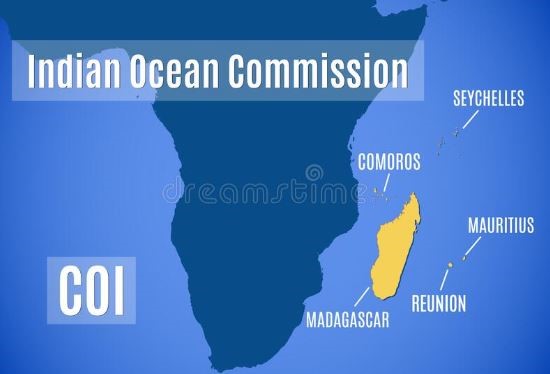
The IOC works on four pillars which have been adopted in 2005 by the Summit of Heads of States:
- Political and diplomatic cooperation,
- Economic and commercial cooperation
- Sustainable development in a globalisation context, cooperation in the field of agriculture, maritime fishing, and the conservation of resources and ecosystems
- Strengthening of the regional cultural identity, cooperation in cultural, scientific, technical, educational and judicial fields.
Significance of IOC
- Over the years, the IOC has emerged as an active and trusted regional actor, working in and for the Western Indian Ocean and implementing a range of projects.
- More recently, the IOC has demonstrated leadership in the maritime security domain. Since maritime security is a prominent feature of India’s relations with Indian Ocean littoral states, India’s interest in the IOC should be understood in this context.
- The IOC has its own regional agenda, and has made impressive headway in the design and implementation of a regional maritime security architecture in the Western Indian Ocean.
- In 2012, the IOC was one of the four regional organisations to launch the MASE Programme — the European Union-funded programme to promote Maritime Security in Eastern and Southern Africa and Indian Ocean. Under MASE, the IOC has established a mechanism for surveillance and control of the Western Indian Ocean with two regional centres.
RMIFC
- The Regional Maritime Information Fusion Center (RMIFC), based in Madagascar, is designed to deepen maritime domain awareness by monitoring maritime activities and promoting information sharing and exchange.
- The Regional Coordination Operations Centre (RCOC), based in Seychelles, will eventually facilitate joint or jointly coordinated interventions at sea based on information gathered through the RMIFC.
- These centres are a response to the limitations that the states in the region face in policing and patrolling their often-enormous Exclusive Economic Zones (EEZs).
-Source: The Hindu
EARTHQUAKE OF 5.3 MAGNITUDE JOLTS PARTS OF GUJARAT
Focus: GS-I Geography, Prelims
Why in news?
An earthquake of 5.3 magnitude shook parts of Gujarat with its epicentre near Bhachau in Kutch district.
The quake was felt in cities like Kutch, Rajkot, Ahmedabad and Patan, where many people rushed out of their houses.
No report to damage to property or life is reported so far.
This Earthquake comes after a string of tremors recorded in a short span of time in and around Delhi.
Earthquake zones of India
- The major reason for the high frequency and intensity of the earthquakes is that the Indian plate is driving into Asia at a rate of approximately 47 mm/year.
- Geographical statistics of India show that more than 50% of the land is vulnerable to earthquakes.
- The latest version of seismic zoning map of India divides India into 4 seismic zones (Zone 2, 3, 4 and 5).
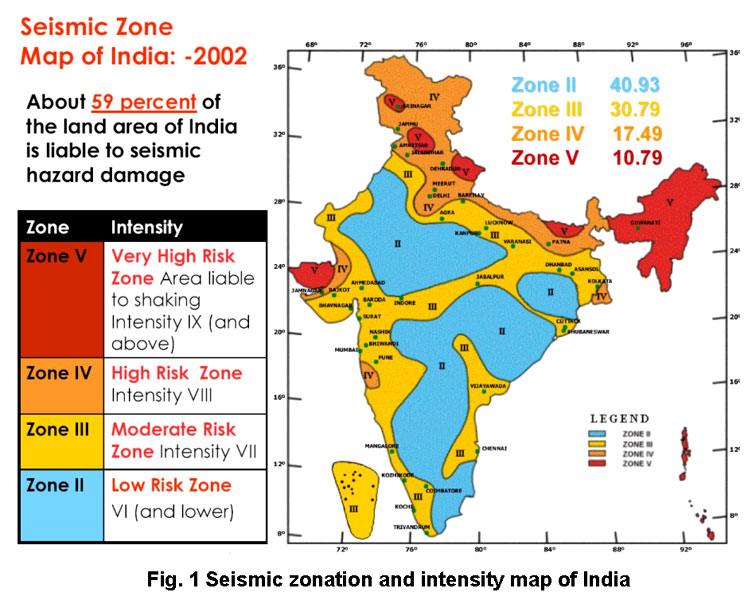
Zones of Seismicity
- Zone 1: Currently the Division does not include a Zone 1. NO area of India is classed as Zone 1.
- Zone 2: This region is liable to MSK VI or less and is classified as the Low Damage Risk Zone.
- Zone 3: This zone is classified as Moderate Damage Risk Zone which is liable to MSK VII.
- Zone 4: This zone is called the High Damage Risk Zone and covers areas liable to MSK VIII. Jammu and Kashmir, Ladakh, Himachal Pradesh, Uttarakhand, Sikkim, the parts of Indo-Gangetic plains (North Punjab, Chandigarh, Western Uttar Pradesh, Terai, North Bengal, Sundarbans) and the capital of the country Delhi fall in Zone 4.
- Zone 5: Zone 5 covers the areas with the highest risks zone that suffers earthquakes of intensity MSK IX or greater. The region of Kashmir, the Western and Central Himalayas, North and Middle Bihar, the North-East Indian region, the Rann of Kutch and the Andaman and Nicobar group of islands fall in this zone.
Measurement of earthquakes
The earthquake events are scaled either according to the magnitude or intensity of the shock.
- Richter scale – The magnitude scale is known as the Richter scale. The magnitude relates to the energy released during the quake. The magnitude is expressed in absolute numbers, 0-10.
- Mercalli scale – The intensity scale is named after Mercalli, an Italian seismologist. The intensity scale takes into account the visible damage caused by the event. The range of intensity scale is from 1-12.
- Medvedev–Sponheuer–Karnik scale – This is a macroseismic intensity scale used to evaluate the severity of ground shaking on the basis of observed effects in an area of the earthquake occurrence.
Richter Scale
The Richter scale, developed in the 1930s, is a base-10 logarithmic scale, which defines magnitude as the logarithm of the ratio of the amplitude of the seismic waves to an arbitrary, minor amplitude.
To understand Logarithmic Scale: an earthquake that registers 5.0 on the Richter scale has a shaking amplitude 10 times that of an earthquake that registered 4.0, and thus corresponds to a release of energy 31.6 times that released by the lesser earthquake. A magnitude 6 earthquake is typically associated with the kind of energy that was released by the atom bomb in Hiroshima.
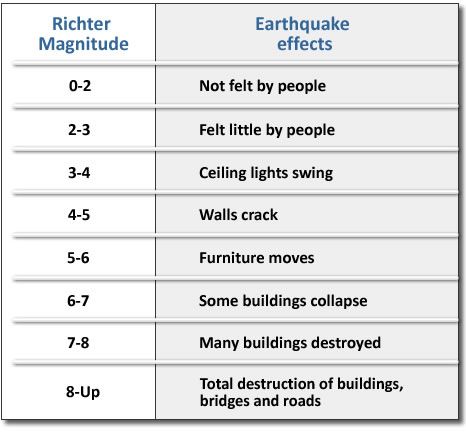
Medvedev–Sponheuer–Karnik scale
The Medvedev–Sponheuer–Karnik scale is somewhat similar to the Modified Mercalli (MM) scale used in the United States. The MSK scale has 12 intensity degrees expressed in Roman numerals.
- I. Not perceptible: Not felt, registered only by seismographs.
- II. Hardly perceptible: Felt only by individuals at rest. No damage to buildings.
- III. Weak: Felt indoors by a few. No damage to buildings.
- IV. Largely observed: Felt indoors by many and felt outdoors only by very few. Moderate vibration. No damage to buildings.
- V. Fairly strong: Felt indoors by most, outdoors by few. Observers feel a strong shaking or rocking of the whole building, room or furniture. Slight damage to a few poorly constructed buildings.
- VI. Strong: Felt by most indoors and by many outdoors. Visible damage to masonry structures, cracks in plaster. Isolated cracks on the ground.
- VII. Very strong: Serious damage to older buildings, masonry chimneys collapse. Small landslides.
- VIII. Damaging: Waves may be seen on very soft ground. Older structures partially collapse or sustain considerable damage. Large cracks and fissures opening up, rockfalls.
- IX. Destructive: Substandard structures collapse. Substantial damage to well-constructed structures. Ground fracturing, widespread landslides.
- X. Devastating: Masonry buildings destroyed; infrastructure crippled. Massive landslides. Water bodies may be overtopped, causing flooding of the surrounding areas and formation of new water bodies.
- XI. Catastrophic: Most buildings and structures collapse. Widespread ground disturbances, tsunamis.
- XII. Very catastrophic: All surface and underground structures completely destroyed. Landscape generally changed, rivers change paths, tsunamis.
-Source: The Hindu
PERSISTENT GLOBAL TRANSMISSION OF CHIKUNGUNYA FROM INDIA
Focus: GS-III Science and Technology
Why in news?
A team from ICMR has noted India as an endemic reservoir for Chikungunya virus with persistent global transmissions from the country.
Indian Ocean lineage
- The whole-genome sequencing study revealed that the isolates belonged to the Indian subcontinent sub-lineage of the Indian Ocean lineage.
- The Indian Ocean lineage is a subgroup within the East Central South African genotype.
- The study showed two separate clusters of Indian Ocean islands sub-lineage and Indian subcontinent sub-lineage.
Spread from clusters
- Observations showed persistent global transmissions from India. The strains from these clusters were noted to have spread to China, Sri Lanka, Bangladesh, and Southeast Asian countries including Indonesia, Malaysia, Singapore and Papua New Guinea beyond mid-2006.
- Transmissions to Yemen, China, Japan, Hong Kong, Pakistan, Australia, Bangladesh and Italy were also noted later on.
- Further studies of the chikungunya sequences revealed indigenous evolution in India at least at three time points over the period 2005-2018.
Chikungunya
- Chikungunya is a viral disease transmitted to humans by infected mosquitoes. It is a mosquito-borne viral disease first described during an outbreak in southern Tanzania in 1952.
- Both Ae. aegypti and Ae. albopictus have been implicated in large outbreaks of chikungunya.
- It causes fever and severe joint pain. Other symptoms include muscle pain, headache, nausea, fatigue and rash. Joint pain is often debilitating and can vary in duration.
- There is no cure for the disease. Treatment is focused on relieving the symptoms.
- The proximity of mosquito breeding sites to human habitation is a significant risk factor for chikungunya.
- The disease mostly occurs in Africa, Asia and the Indian subcontinent. However, a major outbreak in 2015 affected several countries of the Region of the Americas.
-Source: The Hindu
NBWL CALLS FOR STUDY ON IMPACT OF SAND MINING IN U’KHAND
Focus: GS-III Environment and Ecology
Why in news?
The National Board for Wildlife (NBWL) has recommended a study of the impact of the extensive sand and boulder mining projects in Uttarakhand and their impact on river ecology and wildlife.
Details
- There are over 100 sand mining leases operational in the state, according to its geology and mining department.
- NBWL had received three proposals for sand mining along the Asan Wetland Conservation Reserve and five along the Rajaji National Park’s boundary near Haridwar.
- NBWL will not clear the proposals until they comply with the sand mining guidelines, and the National Tiger Conservation Authority’s conditions.
- When several dozen miners work in the river beds around the Park, and hundreds may be thousands of trucks move every day for transport of the material, the anthropogenic pressure and ecological degradation would be serious.
Asan Wetland Conservation Reserve
- The Asan Wetland Conservation Reserve (AWCR) is situated at the confluence of the rivers Yamuna and Asan and forms an important transition zone between riverine and forest ecosystems.
- Located at the valley of Shiwaliks, the picturesque landscape depicting all the successional stages of wetland ecology was India’s first Conservation Reserve in the state of Uttarakhand.
- The Asan Barrage (A barrage is a type of low-head, diversion dam) in the Uttarakhand-Himachal Pradesh border region in Doon Valley, (Dehradun District), northern India, situated at the confluence of the Eastern Yamuna Canal and the Asan River.
National Board for Wildlife
- NBWL was constituted under the Wildlife Protection Act, 1972.
- Hence, NBWL is a Statutory body.
- NBWL has 47 members, with the Prime Minister as the Chairman.
- NBWL is “advisory” in nature and advises the Central Government on framing policies and measures for conservation of wildlife in the country.
- Primary function of the Board is to promote the conservation and development of wildlife and forests.
- It serves as apex body to review all wildlife-related matters and approve projects in and around national parks and sanctuaries.
- It has power to review all wildlife-related matters and approve projects in and around national parks and sanctuaries.
- All the changes or alterations of boundaries in national parks and wildlife sanctuaries require NBWL’s approval.
-Source: Hindustan Times
MALABAR GLIDING FROG SPOTTED AT PULLAD
Focus: GS-III Environment and Ecology, Prelims
Why in news?
Malabar gliding frog (Rhacophorus malabaricus), a rare amphibian that can glide in the air up to 10 to 12 metres, was spotted in Pullad town of Kerala.
Malabar Gliding Frog
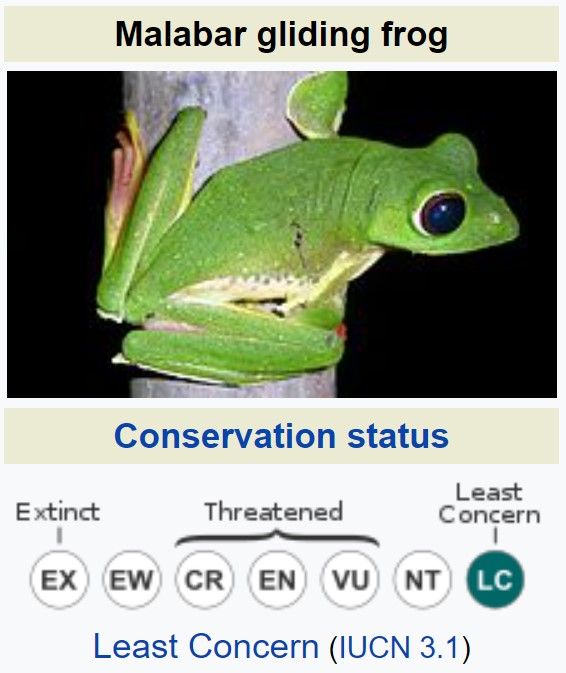
- Malabar Gliding Frog is a rhacophorid tree frog species found in the Western Ghats of India and it is one of the largest mossy frogs.
- Its gliding abilities, with the long skin between the fingers, helped these frogs to cover 10 to 12 feet in one leap.
- The term “gliding” frog refers to its ability to break its fall by stretching the webbing between its toes when making leaps down from the treetops.
-Source: The Hindu



